Seapost -> Picture Postcards (1900 - 1920)
Picture Postcards (1900 - 1920)
By Mike Dovey
The picture postcard, or PPC as it is now commonly known, was a product of the need for a fast and easy way of communicating with simple quick messages at a time long before the telephone was in existence. The picture postcard originated in Europe in the 1860/70's and the use quickly spread across the channel into the British Isles where it was used either for Christmas as a greeting or much more as a way of sending a short message often receiving a reply the same day.
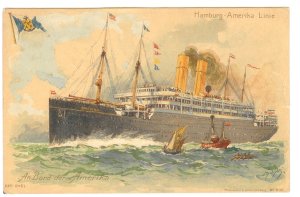
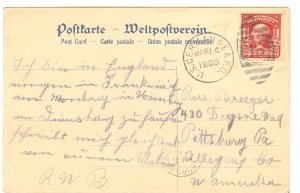
| |
| Hamburg Amerika's "Amerika" | U.S GERMAN SEA P.O. |
|---|---|
Following the new system for posting mail from on board vessels, which had started in 1894, beginning the usage of the paquebot postmark, the shipping companies were quick to join the fast rising fashion of sending a postcard as a message. They quickly realised that a ship could leave their home port with a good stock of postage stamps and a bigger stock of picture postcards depicting the vessel that the passenger was travelling on. In this way not only would the passenger enjoy the delight of sending home a postcard showing the vessel they were on aboard, but the shipping company could actually advertise their vessel, line, and route to all who read the postcard. In this way everybody was onto a winner and by 1900 not only was the postcard enjoying a fantastic success on land but many shipping companies had produced a superb range of postcards which were being posted from all ports along the route of the voyage from leaving the home port to the eventual arrival at ports on the other side of the world.
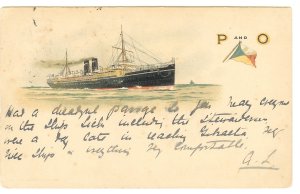
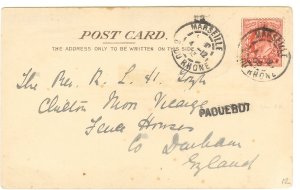
| |
| P&O Line's "MV Arcadia" | Posted at Marseille (Hosking type 410AA) |
|---|---|
One of the first shipping lines to introduce the postcard depicting a vessel of the company was Holland Amerika Line of the Netherlands, closely followed by Hamburg Amerika Line of Germany. In Great Britain the biggest shipping lines to begin using postcards promoting their vessels were the Peninsular & Orient Line (P & O) with routes to India, and Cunard Line and White Star Line who both had a big presence on the Transatlantic routes to North America.

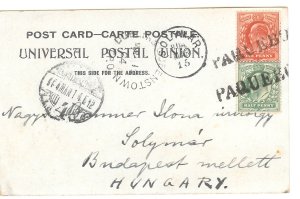
| |
| Cunard Line's "MV Etruria" | Posted at Queenstown (Hosking type 385B) |
|---|---|
These lines were not the only shipping companies to begin using the picture postcard, but, because they carried such enormous numbers of passengers who posted postcards in even bigger quantities, these lines tend to be the most well known because of the sheer bulk of cards that began circulating. Over the years these postcards get disposed of until eventually the few that are left suddenly become valuable, especially if they are posted from a rare port of call. There were other shipping lines who used the same way of promoting their vessels including Royal Mail Line and Pacific Steam Navigation both to South America, Orient Line to Australia, Allan Line and Canadian Pacific to Canada, Aberdeen & Commonwealth to Australia and Bibby Line to Burma.
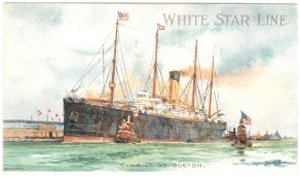
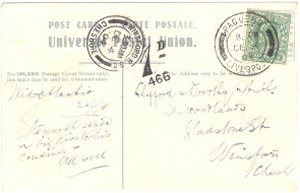
| |
| White Star's "MV Cymric" | Posted at Liverpool (Hosking type 113A) |
|---|---|
The vast majority of postcards posted at ports along the route of the voyage will have a paquebot postmark which is never going to be rare due to the number of times ships posted in these ports. In the case of the P&O vessels to India, paquebot marks are available from Marseille, Valletta, Port Said, Aden, Bombay, Columbo and Calcutta and all are quite common, except in the case of Calcutta since most vessels terminated at either Bombay or Columbo. In the North Atlantic Liverpool, Southampton, Plymouth, New York, and Halifax are all easy to obtain while the ports down the St. Lawrence (Quebec and Montreal) and even Boston can produce marks that are much harder to get hold of. The value of the postcard is not just based on the paquebot cancellation that it bears but also on the actual ship that is depicted.
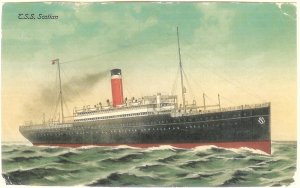
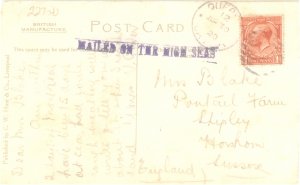
| |
| Allan Line's "MV Scotian" | Posted at Quebec (Hosking type 2270D) |
|---|---|
The number of these cards posted was huge between 1900 and 1914 and again in the 1930's when shipping lines were at their most active. However, with the advent of air travel in the 1950's and the demise of the shipping line, the sale and use of these cards gradually ran down to a mere trickle. Some cruise companies still sell PPC's of their ships but nowadays, when the cards are posted, they will rarely receive a paquebot postmark. The next time you are a passenger on a cruise ship you may specifically ask for your mail to be posted in this way and you may then just strike lucky and be successful. However if you don't ask you will not get. Elsewhere on our website there will be details of just how to go about obtaining paquebot postmarks the next time you go on a cruise ship.
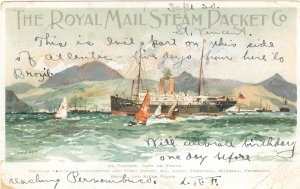
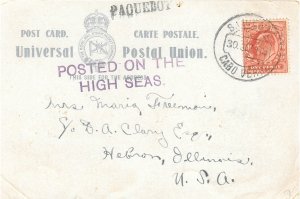
| |
| A Royal Mail Line vessel | Posted at San Vicente (Hosking type 2696A) |
|---|---|

